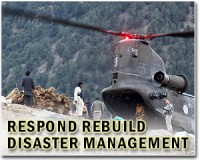 |
Tokyo (AFP) April 14, 2011 Police began searching Thursday for tsunami victims in a 10-kilometre (six-mile) zone around Japan's crippled Fukushima atomic plant where frantic efforts continued to contain a nuclear crisis. Hundreds of police in protective gear for the first time scoured rubble-strewn neighbourhoods near the plant for victims of the giant wave that smashed into Japan's northeast coast more than a month ago. A force of 300 officers was deployed into the no-man's land -- pushing closer towards the plant after they started a wider search on April 3 that covered the outer areas of the 20 km exclusion zone. As the sweep began, emergency crews at the plant pushed on with efforts to stop radioactive leaks into the sea, erecting a seabed silt fence to slow the spread of contaminants out to sea and pumping highly toxic runoff water into tanks. Plant operator Tokyo Electric Power Company (TEPCO) said it was also analysing footage taken by an unmanned helicopter of the tsunami-hit plant and its explosion-charred reactor buildings to assess the damage. A probe of the reactor four containment pool for more than 1,000 fuel rods -- exposed to the sky after a hydrogen blast ripped away the roof -- suggested that some of the rods had been damaged, but that most were intact. Plant workers kept pumping highly toxic runoff water from dousing operations into special tanks, so that they can safely resume the long-term work to restore the plant's original cooling systems and shut the plant down. "We have so far removed some 700 tonnes of water from there," a TEPCO spokesman told AFP. "Even if everything goes smoothly, it will take a few weeks to remove all the leaked water from inside and outside the facilities." Worries lingered over the impact of radioactive spills on marine life after the health ministry said caesium levels 25 times the legal limit had been detected in young sand lance caught off Fukushima prefecture. One sample of the tiny fish, whose sale has been halted since last week, had a caesium level of 12,500 becquerels per kilogram (5,680 per pound), far exceeding the 500 becquerel limit under the Food Sanitation Law, Kyodo News reported. As hundreds of aftershocks have rocked the disaster area, the nuclear regulatory agency has asked TEPCO to check whether the reactor structures need to be reinforced against more seismic rumbles, media reports said. Emperor Akihito meanwhile made his first trip to a disaster-hit area, visiting a shelter in Chiba prefecture for evacuees from the tectonic calamity that killed 13,439 people and left 14,867 missing by the latest count. Police said many bodies were likely still in the area immediately around the plant, and that any irradiated remains would have to be thoroughly washed down before they could be taken away for autopsy and then cremation or burial. "The search started around 10:00 am and will continue until sunset," said a police spokesman. "It's difficult to estimate how many people are still missing in the area. We have to go and find them as soon as possible. "If we find bodies contaminated with high levels of radiation, we will wash the remains before we take them to a morgue." An advisor to Prime Minister Naoto Kan, author and academic Kenichi Matsumoto, caused a stir on Wednesday when he said that the area around the plant may not be habitable for the next 10 or 20 years. He and Kan later stressed that the comment was made by the advisor, not the premier. "The prime minister may share the perception, but he did not say such a thing at all," Matsumoto said. Anger simmered among residents over the nuclear disaster, with evacuees again holding a small protest outside TEPCO's Tokyo headquarters and handing over a petition that called for the facility to be fully decommissioned. bur-hih-si-fz/cc/mtp
Share This Article With Planet Earth
Related Links Bringing Order To A World Of Disasters A world of storm and tempest When the Earth Quakes
 Pakistan flood recovery sees $600 mln shortfall
Pakistan flood recovery sees $600 mln shortfallIslamabad (AFP) April 13, 2011 Pakistan is short of $600 million needed to help millions of families rebuild their lives nine months after the country suffered nationwide floods in its worst ever natural disaster, the UN said Wednesday. The international community was slow to come to Pakistan's aid in the immediate aftermath of last year's monsoon-triggered floods, which affected up to 21 million people, amid allegations ... read more |
|
| The content herein, unless otherwise known to be public domain, are Copyright 1995-2010 - SpaceDaily. AFP and UPI Wire Stories are copyright Agence France-Presse and United Press International. ESA Portal Reports are copyright European Space Agency. All NASA sourced material is public domain. Additional copyrights may apply in whole or part to other bona fide parties. Advertising does not imply endorsement,agreement or approval of any opinions, statements or information provided by SpaceDaily on any Web page published or hosted by SpaceDaily. Privacy Statement |